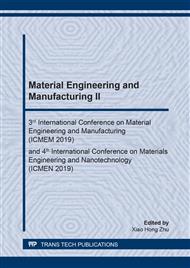[1]
Han, T., Lee, Y., Chio,M., et al. (2012). Extremely efficient flexible organic light-emitting diodes with modified graphene anode. Journal of Nature Photonics, 6(2),105.
DOI: 10.1038/nphoton.2011.318
Google Scholar
[2]
Kim, J., Yasuda, T., Yang, Y., et al. (2013). Bifunctional Star-Burst Amorphous Molecular Materials for OLEDs: Achieving Highly Efficient Solid-State Luminescence and Carrier Transport Induced by Spontaneous Molecular Orientation. Journal of Advanced Materials, 25(19), 2666-2671.
DOI: 10.1002/adma.201204902
Google Scholar
[3]
Slawinski, M., Weingarten, M., Heuken, M., et al. (2013). Investigation of large-area OLED devices with various grid geometries. Journal of Organic Electronics, 14(10), 2387–2391.
DOI: 10.1016/j.orgel.2013.06.003
Google Scholar
[4]
Baldo, M., O'Brien, D., You, Y., et al. (1998). Highly efficient phosphorescent emission from organic electroluminescent devices. Journal of Nature, 395(6698), 151–154.
DOI: 10.1038/25954
Google Scholar
[5]
Williams, J., Stéphanie, D., Rochester, D., et al. (2008). Optimising the luminescence of platinum(II) complexes and their application in organic light emitting devices (OLEDs). Journal of Coordination Chemistry Reviews, 252(23–24), 2596–2611.
DOI: 10.1016/j.ccr.2008.03.014
Google Scholar
[6]
Liu, Z., Qiu, J., Wei, F., et al. (2014). Simple and high efficiency phosphorescence organic light-emitting diodes with codeposited copper (I) emitter. Journal of Chemistry of Materials, 26(7), 2368–2373.
DOI: 10.1021/cm5006086
Google Scholar
[7]
Chen, G., Liu, F., Lin, Z., et al. (2019). Efficient Organic Light Emitting Diodes Using Solution-Processed Alkali Metal Carbonate Doped ZnO. Journal of Frontiers in Chemistry. 7. 266.
DOI: 10.3389/fchem.2019.00226
Google Scholar
[8]
Giebink, N., Forrest, S., et al. (2008). Quantum efficiency roll-off at high brightness in fluorescent and phosphorescent organic light emitting diodes. Journal of Physical Review B, 77(23), 235215.
DOI: 10.1103/physrevb.77.235215
Google Scholar
[9]
Chen, J., Shi, C., Fu, Q., et al. (2012). Solution-processable small molecules as efficient universal bipolar host for blue, green and red phosphorescent inverted OLEDs. Journal of Materials Chemistry, 22(11), 5164-5170.
DOI: 10.1039/c2jm16463a
Google Scholar
[10]
Guo, K., L, W., Zhang, J., et al. (2016). Extremely high external quantum efficiency of inverted organic light-emitting diodes with low operation voltage and reduced efficiency roll-off by using sulfide-based double electron injection layers. Journal of RSC Adv, (6), 55626.
DOI: 10.1039/c6ra08191f
Google Scholar
[11]
Chan, M., Lai, S., Lau, K., et al. (2007). Influences of Connecting Unit Architecture on the Performance of Tandem Organic Light-Emitting Devices. Journal of Advanced Functional Materials, 17(14), 2509-2514.
DOI: 10.1002/adfm.200600642
Google Scholar
[12]
Guo, K., Wang H., Wang Z., et al. (2016). Stable green phosphorescence organic light-emitting diodes with low efficiency roll-off using a novel bipolar thermally activated delayed fluorescence material as host. Journal of Chemical Science, 8, 1259–1268.
DOI: 10.1039/c6sc03008d
Google Scholar
[13]
Chen, M., Zhao, Y., Tang, Z., et al. (2019). Multifunctional Organic Emitters for High-performance and Low-cost Organic Light-emitting Didoes. Journal of The Chemical Record, (19), 1–12.
DOI: 10.1002/tcr.201900005
Google Scholar
[14]
Höfle, S., Schienle, A., Bruns, M., et al. (2014). Enhanced electron injection into inverted polymer light‐emitting diodes by combined solution-processed zinc oxide/polyethylenimine interlayers.Journal of Advanced Materials, 26(17), 2750-2754.
DOI: 10.1002/adma.201304666
Google Scholar
[15]
Zhang, K., Zhong, C., Liu, S., et al. (2014). High efficiency solution processed inverted white organic light emitting diodes with a cross-linkable amino-functionalized polyfluorene as a cathode interlayer. Journal of Materials Chemistry C, 2(17), 3270-3277.
DOI: 10.1039/c3tc32022g
Google Scholar
[16]
Thomschke, M., Hofmann, S., Olthof, S., et al. (2011). Improvement of voltage and charge balance in inverted top-emitting organic electroluminescent diodes comprising doped transport layers by thermal annealing. Journal of Applied Physics Letters, 98(8), 44.
DOI: 10.1063/1.3559847
Google Scholar
[17]
Höfle, S., Schienle, A., Bruns, M., et al. (2014). Enhanced electron injection into inverted polymer light-emitting diodes by combined solution-processed zinc oxide/polyethylenimine interlayers. Journal of Advanced Materials, 26(17), 2750-2754.
DOI: 10.1002/adma.201304666
Google Scholar
[18]
Lee, H., Kang, C., Park, M., et al. (2013). Improved efficiency of inverted organic light-emitting diodes using tin dioxide nanoparticles as an electron injection layer. Journal of ACS applied materials & interfaces, 5(6),1977-1981.
DOI: 10.1021/am302787y
Google Scholar
[19]
Negi, S., Mittal, P., Kumar B., et al. (2018). Impact of different layers on performance of OLED. Journal of Microsystem Technologies, 24(12), 4981-4989.
DOI: 10.1007/s00542-018-3918-y
Google Scholar
[20]
Lv, Y., Zhou, P., Wei, N., et al. (2013). Improved hole-transporting properties of Ir complex-doped organic layer for high-efficiency organic light-emitting diodes.Journal of Organic Electronics, 14(1), 124-130.
DOI: 10.1016/j.orgel.2012.09.042
Google Scholar


